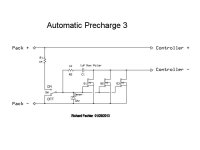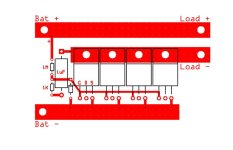izeman
1 GW
fechter said:2.5mm2 wire should be OK, but a little small. As long as they are short, there won't be much loss.
The reason for the ground connection on the switch is to speed up the turn-off. It will work without it, but when you turn the switch off, it might take 30 seconds before it really turns off. This might be OK in most cases. It might be bad in an emergency, like stuck throttle. It would also be bad if there was a heavy load (motor running) when you turn it off.
thanks. voltage drop should be minimal. and i can live with that.
i thought that switching to ground would speed up shut down, but wasn't sure. reasonable if you need it as kill switch. my switch will not be near my handlebars, so in case there is an emergency i won't be able to reach it anyway
i tried with a single fet, and it seems there is no real ramp up. my voltmeter needs some tenth of a second to show voltage, but it's definetly not 2s until full voltage goes through.







